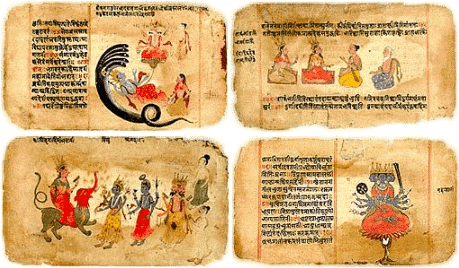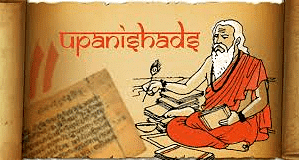Literature
- Veda means knowledge, comes from the root vid (to know). They are given the titles of Apaurusheja (not made by man) and Nitya (eternal).
 Literature - Vedic Period
Literature - Vedic Period - The Veda consists of four different classes of literary composition, namely Mantras, Brahmanas, Aranyakas and Upnishads.
- Mantras: (saying, song, formula) consists of the oldest division of Vedic literature and is distributed in four samhitas (or collection); Rig Veda Samhita, Sam Veda Samhita Yajur Veda, Samhita and Athrva Veda Samhita. The first three are known as Trayi (three fold knowledge).
- Samhita of Rig Veda is a collection of lyrics in praise of different gods. These were recited by the priest styled Hotri. It contains 1028 hymns, divided into 10 mandalas and some times into 8 astakas. But the former division is more popular. II-VII mandalas are the earliest and are also called family books. They are attributed to Gritsamada, Visvamitra, Vasudev, Attri, Bhardwaj and Vashistha. Mandala VIII is attributed to Kanva and Angiras. Mandala IX is attributed to Soma.
- It gives us an insight into the political, social, economic and religious life of the people of Rig Vedic India.
- Samhita of Sam Veda - (books of chants) - All of its verses except 75 being taken directly from Rig-veda. These verses are given tune for the purpose of singing. Its songs were meant to be sung at some sacrifice by a special class of priests called Udgatri. It shows that Aryans loved music and were not marely puritans.
- Samhita of Yajur Veda (book of sacrificial prayers) - It deals with the procedure for the performance of sacrifices. It contains rituals as well as hymns. Recited by Advaryu.
- It can be divided into two parts:
- (a) Shyama Yajur Veda (Black Yajur Veda) - It is older and contains commentary in prose in addition to the text.
- (b) Sukla Yajur Veda (White Yajur Veda). It contains instructions only.
- Samhita of Athrva Veda (book of magical formula) also known as non-Aryan work some of its hymns are as old as the earliest hymns of Rig-veda. From the historical and scientific point of view resembles the Rig Veda, however its spirit is different. It is divided into 20 books.
Upanishads
It is a collection of songs, spells and incantations for the cure of disease, the restoration of harmony and the exorcism of evil spirit etc.
- The Aitareya and Kaushitaki Upanishads belong to Rig Veda.
- Chandogya and Kena Upanishad belong to Sama Veda
- Taittiriya, Katha and Svetasvata belong to the Krishna Yajur Veda.
- Brihadaanyaka and Isa belong to the skla Yajur Veda
- Prasna, Mundaka and Mundukya belong to the Atharva Veda.
(2) Brahmanas—They marked the transition from the Vedic to later Brahmanical social order.
- They explain meaning of sacrifices and also the methods of performing them.
- They are commentries on various hymns of the Vedas to which they are appended.
- Each Brahmana is connected with one of the Samhitas.
- The three Brahmanas contain a lot of information about the non-Aryans and also tell us the methods by which the non-Aryans were to be admitted into the Aryan fold.
- To Rig Veda - Aitareya Brahmana and Kaushtaki Brahmana.
- To Sama Veda - Tandya-maha Brahmana, Sadvinsa Brahmana, Jaiminiya Brahmana.
- To Yajur Veda - Satapatha Brahmana; most exhaustive and most impotant of all the Brahmanas; points out the progress of culture from Panchala to Videha.
- To Atharva Veda - Gopatha Brahmana
- The difference between the Brahmanas connected with the various Vedas lies in the fact that the Brahmanas of the respective Vedas deals with the work of different priests.
- As regards their fundamentals all the Brahmanas agree with one another to a very great extent.
- Aranyakas (forest book) -These are the books of instructions to be given in the forest meant for wood dwelling hermits.
- They are found as appendices to the Brahmanas.
- It marks the transition from ritualistic to philosophical thought.
- Upanishads (secret or esoteric doctrine) - Its name is derived from UPANISAD i.e “to sit near some one”. - There are 108 Upnishads altogether. - They contain deep speculations of a philosophical character which revolve around the two concepts of Brahma and Atma.
Comparison between Dravidian and Aryan Culture
- The Dravidians did not initiate and practise a social theory like Aryan theory of varnashrama—Brahmanas, Kshtriyas, Vaishyas and Shudras.
- The caste-system, the very framework of the Aryan society, was conspicuous by its absence in the Dravidian society.
- The Dravidian laws of matrimonial alliances differed fundamentally from those of the Aryans. The Dravidians could marry within the fold of their blood relations, while the Aryans were denied this privilege.
- The social system of Dravidians, being matriarchal, was quite in contradiction to the patriarchal system of the Aryans.
- Their mode of life, customs, manners, religion and languages differed from those of the Aryans.
Differences between the Indus Valley Civilization and the Vedic Culture
- Harappan civilization was superior to that of the Vedic culture.
- Indus Valley Civilization was an urban civilization whereas the Aryan culture was pastoral.
- The Indus valley people made use of only copper and bronze and iron was not known to them.
- There was brisk trade (inland and foreign) during the Harappan period.
- Humped-bull was probably a sacred animal to the Indus valley people whereas cow occupied a sacred place among the Aryans.
- The Indus valley people worshipped mother gooddesses.
- The Indus valley society was theocratic in nature. But the Aryan society was secular.
- The Indus valley people, although they are not artistic, made considerable progress in the field of art. Whereas the Aryans though possessed an artistic temperament failed to leave any signs of such craftsmanship.
- The Harappan people buried their dead bodies while the Aryans burnt them.
- The Indus people practised the cult of Sakti and Pasupati and worship of animal, tree, stone, phallus and yoni.
- Aryan religion is mainly concerned with sky.
- The Indus people traded with foreign countries but did not adopt their positive things. They believed in isolation The plasticity of the Aryan mind is shown in the quick adoptation of agriculture and settled life as well as the use of language which in the Rig Veda rises to musical levels. This capacity of change and adapt has given continuity to Indian civilization.
No comments:
Post a Comment